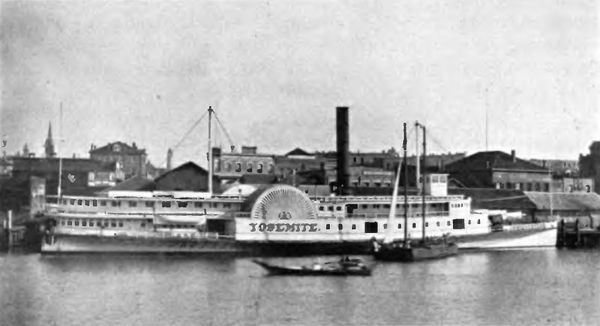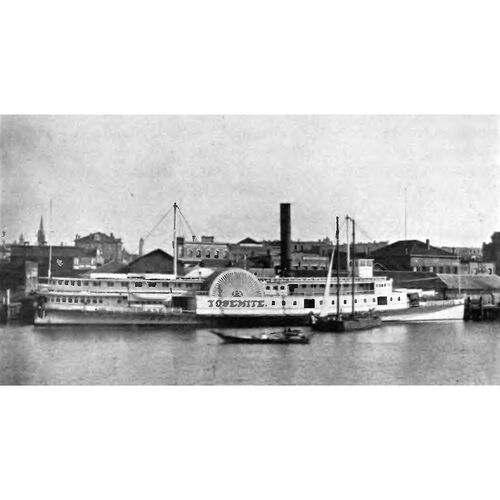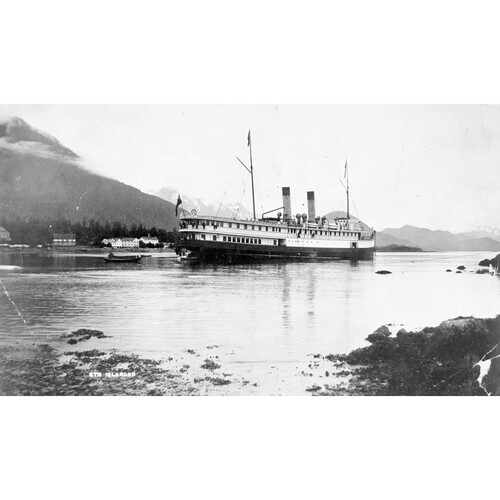
Source: Courtesy of Wikimedia Commons
Irving, John, steamship captain, company manager, and politician; b. 24 Nov. 1854 at sea en route to Portland (Oreg.), son of William Irving*, a ship’s captain, and Elizabeth Jane Dixon; m. 12 June 1883 Jane Munro in Victoria, and they had two daughters and one son; d. 10 Aug. 1936 in Vancouver.
John Irving was born on the ship Robert D. Carter, under charter to his father, shortly before it arrived in Portland. In 1859, during the Fraser River gold rush, he moved with his family from Portland to New Westminster in the mainland colony of British Columbia. His father established the family’s holdings in shipping, acquiring a share and soon a controlling interest in the British Columbia and Victoria Steam Navigation Company. He sold these assets in 1862 and then formed the Pioneer Line Company to operate vessels on the Fraser River. John, who had received his elementary education in Victoria, soon learned the trade from his father and by working as a deckhand on Pioneer Line ships. Although it seldom had more than a few vessels in service at one time, the firm would dominate the Fraser River trade until the mid 1880s. In addition, during the early 1870s it was active on the Stikine River.
After his father’s death in 1872, John, who was only 17, took over the business with the help of his mother and an uncle. In the spring of 1873 he became captain of the steamer Onward, which plied the lower Fraser. He developed a name for being a skilled, aggressive captain and businessman. In competition with other owners, he frequently outmanoeuvred them by expert piloting, shrewd business strategies, or both; on other occasions he purchased their operations, adding to his reputation for boldness. Historians Norman Rupert Hacking and William Kaye Lamb* describe him as having a “naturally reckless disposition.” According to Hacking, the captain was also colourful. “Well over 6 feet in height, handsome John Irving was a great social favourite, a mighty drinker, and the soul of generosity.”
Irving married Jane Munro, daughter of Hudson’s Bay Company chief factor Alexander Munro, in 1883. They would initially make their home in Victoria, where they had a substantial residence near the legislative buildings, and then move to Vancouver. Their only son, a major in the Canadian Expeditionary Force, would be killed in France in 1916. In addition to his shipping concerns, Irving had interests in a sawmill at Moodyville (North Vancouver) and, after its establishment in 1886, in the Vancouver Water Works Company, a private utility of which he would later be president.
In 1883 Irving and other investors, including Robert Paterson Rithet*, a prominent businessman who had married Jane Munro’s sister, had formed a joint-stock enterprise based in Victoria; the Pioneer Line was merged with the Hudson’s Bay Company’s river and coastal shipping operations to form the Canadian Pacific Navigation Company (not affiliated with the Canadian Pacific Railway). William Charles* of the HBC was named chairman; Irving, who was captain of the Yosemite at the time, also became manager of the new firm, which had an authorized capital of $500,000. He oversaw the purchase or construction of several significant additions to the CPNC’s fleet, including new coastal steamers such as the Premier in 1887 and the luxurious Islander in 1888. These ships significantly improved freight and passenger services between Victoria, Vancouver, New Westminster, and other locations. The expansion of the fleet in the late 1880s put the company in a good position to develop the coastal trade, and it was the largest shipping concern in the region. Irving organized excursions to northern British Columbia and to southern Alaska that promoted the area, emphasizing its resources and scenic attractions. In 1898 he ordered the river steamer Beaver, the first steel-hulled vessel built in the province.
A determined man, Irving was undaunted by difficulties, ready to take business gambles, and impatient with legal niceties. For example, his new steamer the Elizabeth J. Irving, uninsured, was a total loss after a fire on 29 Sept. 1881, and in 1892, after the CPNC’s United States-registered Premier was damaged during a collision in Admiralty Inlet, Wash., he had the vessel brought back to Canada before it could be seized. Renamed the Charmer, it would never return to American waters.
Expanding his shipping interests, Irving had formed the Columbia and Kootenay Steam Navigation Company Limited in 1890. The firm had an authorized capital of $100,000. Among the investors were John Andrew Mara and Frank Stillman Barnard, who, with Irving, soon gained control of the company. This venture had sternwheelers on the lakes and rivers of southern British Columbia, providing connecting services to the recently completed CPR at Revelstoke. The area was becoming a significant mining region and, because of its close proximity to the United States, the company played an important role in retaining the traffic in the province. In 1896–97 the firm, consisting of a tug, six sternwheelers, and ten barges as well as shipyards and other facilities, was sold to the CPR; it would become the CPR’s British Columbia Lake and River Service. In another enterprise, Irving, with partners Senator James Reid and businessman Stephen Tingley, had the steamer Charlotte built at Quesnel in 1896 for service on the upper Fraser to Fort George (Prince George). Operating as the Northern British Columbia Navigation Company, they would run the steamer until 1910, when it was wrecked.
At the time of the Klondike gold rush during the winter of 1897–98, the CPNC sent steamers twice monthly to northern communities and the Queen Charlotte Islands (Haida Gwaii), weekly to southern Alaska, three times a week to Barkley Sound and the west coast of Vancouver Island, thrice weekly between Victoria and New Westminster (also serving the Gulf Islands), and daily (except Monday) on a return service between Victoria and Vancouver. In 1898 Irving had the river steamer Yukoner outfitted for the CPNC by Alexander Watson in St Michael (Alaska), near the mouth of the Yukon River. That year, in one of his most famous exploits, Irving took the steamer, with a full and boisterous crowd of passengers and a substantial cargo, upstream to Dawson, Y.T., in a record 14 days. After returning to St Michael, for reasons that are not known, he sold the vessel, apparently at a loss. The following year he founded the John Irving Navigation Company, which operated sternwheelers in the southern Yukon and northern British Columbia on Tagish and Atlin lakes.
A Presbyterian, Irving was elected a Conservative member of the Legislative Assembly of British Columbia in July 1894 and again in July 1898 for Cassiar, in the northwestern part of the province. Despite his strong support of the mining industry, he failed to retain his seat in 1900. He would run again, in Atlin in 1907 and 1909, but would lose both contests to Henry Esson Young.
In 1901, apparently financially overextended, Irving sold his coastal shipping interests. By this time the CPNC was coming under growing criticism because of its aging fleet and the need for expanded services. Irving and his associates lacked the resources to make the investments. The CPR purchased the CPNC for $531,000, and his upper Yukon River system vessels, the sternwheelers Gleaner and Scotia, changed ownership. Given a lifetime permit for the CPR’s coastal steamships, he was welcome on board and travelled often. After the sale of his shipping interests, his fortune declined despite his investments in mining and other ventures. During 1911–12, a period of high real-estate prices and speculation, he worked as a real-estate agent. He lost or gave away much of his wealth. Hacking, who knew Irving late in life, remembered him as “poor in everything but friends.” He died in Vancouver in 1936. His wife then moved to England to live near her daughters and died there in March 1955.
John Irving’s role in the development of coastal and inland shipping services in British Columbia during the late 1800s was significant, and he was certainly one of the most outstanding and most colourful figures in the transportation industry during this period.
BCA, GR-2951, no.1936-09-517278 (mfm.); GR-2962, no.1883-09-002608 (mfm.); MS-1033. British Columbian (New Westminster, B.C.), 11 Aug. 1936. Daily Colonist, 11 Aug. 1936, 30 March 1955. Vancouver Daily Province, 11 Nov. 1926, 11 Aug. 1936. Victoria Daily Times, 11 Aug. 1936. British Columbia: pictorial and biographical (2v., Winnipeg, 1914), 2: 692–95. “Capt. John Irving, m.p.p.,” Mining Record (Victoria), 2 (1896), no.11: 14–15. A century of paddlewheelers in the Pacific northwest, the Yukon and Alaska, comp. E. L. Affleck (Vancouver, 2000). Art Downs, Paddlewheels on the frontier: the story of British Columbia and Yukon sternwheel steamers (Sidney, B.C., 1972). N. R. Hacking, “British Columbia steamboat days, 1870–1883,” British Columbia Hist. Quarterly (Victoria), 11 (1947): 69–111. N. R. Hacking and W. K. Lamb, The “Princess” story: a century and a half of west coast shipping (Vancouver, 1974). J. B. Kerr, Biographical dictionary of well-known British Columbians, with a historical sketch (Vancouver, 1890), 204–5. Lewis & Dryden’s marine history of the Pacific northwest; an illustrated review of the growth and development of the maritime industry …, ed. E. W. Wright (Portland, Oreg., 1895; repr. Seattle, Wash., 1967). Archie Miller and Valerie Francis, Irving House, a family history (New Westminster, 1988). R. D. Turner, Sternwheelers and steam tugs: an illustrated history of the Canadian Pacific Railway’s British Columbia Lake and River Service (Victoria, 1984).
Cite This Article
Robert D. Turner, “IRVING, JOHN,” in Dictionary of Canadian Biography, vol. 16, University of Toronto/Université Laval, 2003–, accessed January 20, 2025, https://www.biographi.ca/en/bio/irving_john_16E.html.
The citation above shows the format for footnotes and endnotes according to the Chicago manual of style (16th edition). Information to be used in other citation formats:
| Permalink: | https://www.biographi.ca/en/bio/irving_john_16E.html |
| Author of Article: | Robert D. Turner |
| Title of Article: | IRVING, JOHN |
| Publication Name: | Dictionary of Canadian Biography, vol. 16 |
| Publisher: | University of Toronto/Université Laval |
| Year of revision: | 2015 |
| Access Date: | January 20, 2025 |




